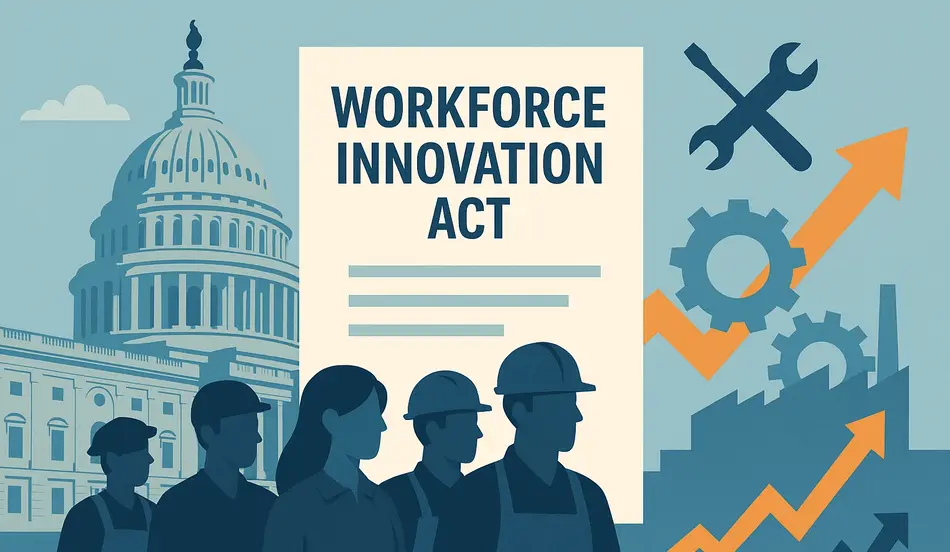On July 16, 2025, the U.S. House of Representatives voted overwhelmingly to pass the Workforce Innovation Act (H.R. 7821), a landmark bipartisan effort aimed at alleviating the nation’s persistent skilled labor shortage. The legislation commits nearly $40 billion over six years to revamp and expand critical workforce development and training programs. Advocates say the act will help connect millions of Americans to in-demand careers while equipping employers with a more capable talent pipeline.
1. Background: A Growing Skills Gap
Over the past decade, employers across manufacturing, construction, healthcare, and technology sectors have reported difficulty filling open positions that require technical or vocational training. According to a 2024 survey, 60% of business leaders indicated that recent graduates lack job-ready skills, and 7.7 million positions remained unfilled due to this mismatch . This disconnect has stymied productivity and contributed to wage stagnation in certain industries.
In response, Congress drafted H.R. 7821 to modernize and reauthorize the Workforce Innovation and Opportunity Act (WIOA) of 2014. Unlike previous extensions, this new bill dramatically increases funding and introduces targeted reforms to align training programs with regional employer needs.
Struggling to Fill Skilled Roles?
The talent gap is real — but you don’t have to wait for the perfect candidate to walk in. Post your job on WhatJobs and connect with millions of skilled professionals actively seeking opportunities across healthcare, tech, trades, and more.
Post a Job Now2. Key Provisions of the Workforce Innovation Act
- Enhanced Funding for Skills Development:
At least 50% of adult and dislocated worker funds must now be directed to competency-based training, including on-the-job apprenticeships and employer-led programs. - Stronger Industry Partnerships:
States and local workforce boards are required to collaborate with employers to develop standardized assessments that validate both existing and newly acquired skills. - Innovation Fund for Evidence-Based Programs:
A new Workforce Development Innovation Fund will seed pilot projects that demonstrate measurable gains in placement rates and wage growth. - Support for Disconnected Youth and Formerly Incarcerated Individuals:
The act codifies grants to help young people not in school or work—and individuals transitioning from incarceration—access career pathways and wrap-around services. - Expanded Adult Education and Literacy Services:
Funding for English language learning and basic skills education will be increased, particularly in underserved rural and outlying territories.
3. Bipartisan Support and Floor Vote
The bill received strong cross-party backing, passing the House by a vote of 378–26. Proponents from both sides emphasized that workforce development is critical for maintaining U.S. competitiveness in a rapidly evolving global economy. Chairwoman Virginia Foxx (R-NC) highlighted the importance of “elevating skills development” as “the currency of the labor market,” while Ranking Member Bobby Scott (D-VA) noted that “this investment will fill openings with qualified workers and spur economic growth”
4. Reactions from Industry and Advocates
- Associated General Contractors of America (AGC):
“This act will strengthen connections between employers and the workforce system, ensuring in-demand trades receive the support they need.” - AARP:
“Modernizing WIOA programs to better align with today’s labor market will help older job seekers access career services and remain competitive.” - LinkedIn and America Forward Coalition:
Praised the “skills-first” emphasis and urged swift passage in the Senate.
5. Implications for Employers and Job Seekers
For Employers:
- Access to a broader pool of job-ready candidates via new apprenticeship and training incentives.
- Opportunity to co-design curriculum and assessments, ensuring graduates meet exact workplace requirements.
For Job Seekers:
- Expanded eligibility for individualized training accounts, allowing workers to choose programs that match their career goals.
- Enhanced wrap-around services—such as childcare, transportation assistance, and digital literacy courses—aimed at reducing barriers to participation.
6. Next Steps: Senate Consideration and Implementation
With House approval secured, attention now turns to the Senate, where Majority Leader Chuck Schumer has indicated support for swift Floor action. If passed, the legislation will head to President Biden’s desk for signature. Upon enactment, the Department of Labor will issue guidelines to state workforce boards within 90 days, and funding allocations will begin in Fiscal Year 2026.
Conclusion
The Workforce Innovation Act represents one of the most significant overhauls of federal job-training policy in over a decade. By injecting targeted funding, strengthening employer partnerships, and prioritizing evidence-based programs, the bill aims to close the skilled labor gap that has hampered sectors across the U.S. economy. As the legislation moves to the Senate, stakeholders on both sides of the aisle will be watching to ensure its timely passage and effective implementation.
FAQ
What is the Workforce Innovation Act?
A bipartisan bill (H.R. 7821) that reauthorizes and expands the Workforce Innovation and Opportunity Act, directing nearly $40 billion toward job training over six years.
When will the new programs take effect?
Funding allocations begin in Fiscal Year 2026, with state guidelines due within 90 days of enactment.
How does the act support underrepresented groups?
It codifies grants for disconnected youth and formerly incarcerated individuals and boosts investment in adult literacy and workforce reintegration services.
What’s next?
The Senate is expected to debate and vote on the bill in the upcoming legislative session, with a goal of presidential signing by late 2025.
How can employers get involved?
Employers can partner with local workforce boards to co-design training curricula and apply for Innovation Fund grants to pilot new programs.




